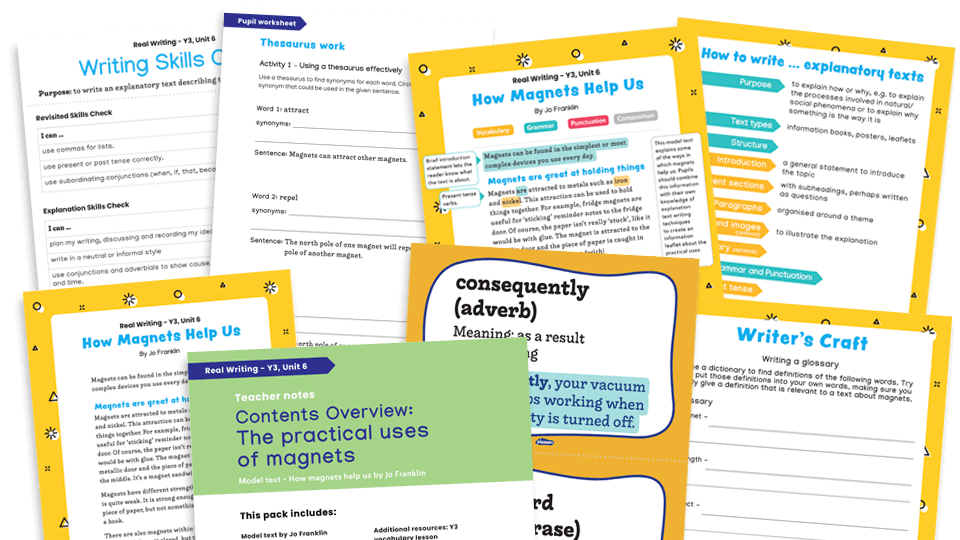If you want to teach your class how to write an explanation text confidently, let teacher Sue Drury enlighten you with this excellent advice...
If there was ever a word that forced you to demonstrate your understanding, it’s the question “Why?”. That's why providing explanations is such an important skill for pupils.
However, there is typically much more to providing a written explanation than a verbal one. There are conventions to follow and features to include.
What is an explanation text?
First, we need to clearly establish just what an explanation text is. In a way, it's rather like any other information text. However, it goes beyond saying “what” to saying “why”.
This is a distinction that younger pupils can find difficult to grasp, so it is worth emphasising that point.
You could argue that an instructional text is a form of explanation. However, instructions tend to have their own conventions, not least the use of imperative verbs. Therefore, it's probably best to consider them a separate genre.
Explanation texts – structure activity resources
It’s always a good idea to provide pupils with high-quality examples of whichever text type you are teaching. Hopefully, you should be able to find explanations in decent non-fiction books.
However, if you’re struggling, it might be worth getting hold of a model text written specifically for teaching purposes.
The first thing you want from your example is a full range of structural features you would expect your pupils to incorporate into their own efforts. At the bare minimum, these ought to include a general introductory statement and information arranged in a logical order.
We offer this great resource pack that provides explanation text examples and specially designed planning sheets to help give KS2 students the best possible foundations for getting to grips with this genre.

We also have some excellent explanation text WAGOLLs in our Real Writing collection, all written by published children's authors. These include ‘How Magnets Help Us’ (Y3); ‘Terrific Teeth’ (Y4); ‘The Life Cycle of a Frog’ (Y5) and ‘The Workings of the Human Heart’ (Y6).

Language features – tense
This is a good text for ticking those ‘uses tenses consistently’ boxes on your assessment sheets. Because they often, by definition, show what happens as a general rule, explanations provide an excellent vehicle for practising the use of the present tense.
Of course, you would have to explain that ‘consistently’ does not mean ‘exclusively’, especially when dealing with historical information.
Nevertheless, the present tense should dominate, assuming you have chosen your subject matter wisely.
Explanation writing checklist – logic
An explanation will typically give a step-by-step account of the stages or phases in a particular process. That means pupils need to be fully aware of the sequence in which things happen so that they can explain them in a logical order.
As you can imagine, detailed planning is particularly important here. But a good plan will probably not be enough on its own.
To convey the logic and order effectively, pupils will need to include a good selection of conjunctions, adverbials (including fronted adverbials) and prepositions. For younger writers, this is a great opportunity for using words like if, when and, of course, because.
Higher up the school, they can introduce shades of possibility by using modal verbs and find advanced ways of weaving in extra information by including features such as relative clauses. These are often a sign of a writer’s maturity
Punctuation in an explanatory text
Another bonus for teachers is the range of punctuation that can be legitimately included in an explanation text. In KS1, this could well involve commas for lists and question marks, especially when using question sentences as subheadings.
As they get older, they can practise using dashes, brackets and commas to insert extra information in parenthesis. They could even try including those bad boys of punctuation that even most adults struggle with: colons and semicolons.
If you think it would be wise for them to practise first, try our SPaG challenge mat resource which helps pupils to gain a better understanding of colons and semicolons before challenging, testing, applying and, yes, explaining that knowledge.

Which layout devices should be used?
Another of the key features of an explanation text is the use of layout devices. As we mentioned earlier, one of the crucial elements of an explanation is the logical presentation of the material.
This is often enhanced by the inclusion of ‘signposts’ to the reader, such as headings and subheadings, including those which are worded as questions.
There might also be scope for including bullet points as a way of marshalling key facts efficiently and presenting them in an eye-catching way for the reader.
Depending on the subject matter, you could even invite pupils to include diagrams, tables and charts, although you might want to avoid the emphasis of the lesson switching from writing to art.
If you want to help your class practise using these features beforehand, why not use our Year 6 ‘Tricky grammar story starters’ resource worksheet for layout devices?
This uses an arresting image to stimulate discussion before tasking pupils with including these features in a piece of writing on a topic familiar to them.

Main purpose of an explanation text – explain
Above all, however, you need to urge your pupils to check that their work has achieved what it set out to do: explain.
Therefore, this might be the perfect genre for peer marking, not just for identifying all the many features outlined above, but also for getting another perspective.
After all, if your explanation does not make sense to your peers, it probably won’t make sense to anybody else!
Sue Drury qualified as a primary teacher in 1999. Teaching pupils from Year 1 to Year 8, she has held a variety of positions including maths and English subject leader, year leader, and assistant headteacher. Sue has mentored students and NQTs, offering guidance and advice using her years of experience. She created many of Plazoom's literacy resources.